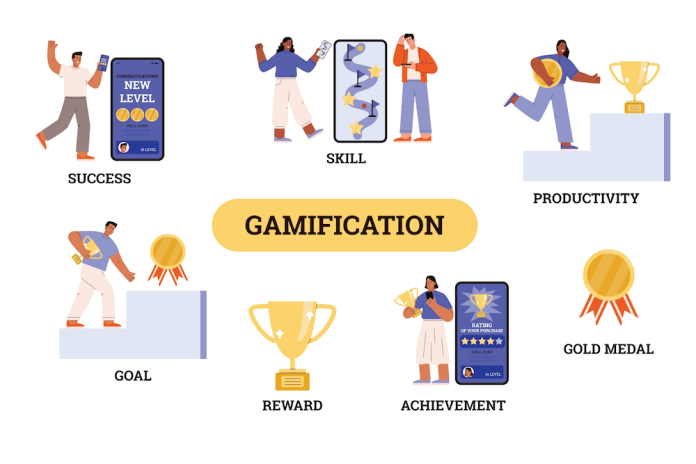
Play-based learning was a part of human society long before the name, “gamification,” was used, and studies have consistently proven that play is one of the most effective learning tools for boosting engagement and retaining information. Our brains are most stimulated when dry facts are reimagined through the lens of gameplay. But gamification is not a one-size-fits-all strategy.
A game-based approach can enhance most content, but you need to pick the right methods and strategies for your project. Not every learning initiative will benefit from a leaderboard or trophies.
To develop the right gamification strategy, it is important to use game mechanics and systems in an intentional way that complements the learning topic. When applied successfully, you get something that’s stimulating and memorable for your audience.
Exemplar: Using Gamification to Make Learning a Habit
Language-learning app Duolingo is an exemplar of gamification done well. Duolingo’s gamification strategy is designed to turn the learning process into a habit, making it as appealing as possible for users to come back day after day for sustained periods. To do this, it uses common (but effective) elements such as daily quests, reward streaks, difficulty levels, and trophies. The app’s tongue-in-cheek push notifications that encourage learners don’t hurt either.
The combination of these game-like elements makes Duolingo particularly effective at encouraging learners to keep coming back by appealing to their natural desire to receive praise, gain achievements, engage in competition, and demonstrate mastery.
What Does Ineffective Gamification Look Like?
A few years ago, car service Lyft attempted to influence customer behavior by awarding users badges for traveling at certain times, on certain days, or when sharing a ride. However, there was no meaningful goal or sense of reward for collecting the badges, and the activity required to get a badge was something customers likely were already doing. Nobody takes an unnecessary cab ride just to earn a digital badge for no discernible reason.
In this case, the behavioral economics behind the gamification strategy were poorly understood and didn’t lead to the desired changes in customer activity.
Finding the Right Gamification Strategy for Your Learning
Before deciding on a gamification strategy for your project, be clear about the behavioral outcomes it needs to achieve. Are you trying to promote positive habits? Encourage collaboration and teamwork? Impart technical knowledge? These goals are all different, and so are the gamification strategies you might use to achieve them.
You also need to consider what game mechanics will appeal to your target audience. Do your learners prefer the slow burn and intrigue of a complex branching narrative? What about a set of head-scratching puzzles? Or maybe a competitive, rapid-fire quiz is more their style?
3 Gamification Strategies: Challenge, Immerse, and Play
Let’s look at some real examples of learning outcomes and the gamification strategies we used to achieve them. These strategies—Challenge, Immerse, and Play—all seek to enhance learning outcomes through gamification but use different methods and mechanics to get there.
Challenge: Onboarding New Starters
The Challenge strategy engages learners by setting a relevant problem for them to solve, applying meaningful stakes, and giving learners interesting tools to work with. For a recent onboarding project, we used this approach to introduce new people to the organization’s culture by having them solve a complex, multi-layered puzzle with answers that relate to their new role and team.
Learners like it when we respect their intellect by not spoon-feeding them and by daring them to think deeply, use their logic and reasoning, and allow them to sometimes get the answer wrong. Our puzzle was intentionally complex, and we encouraged curiosity by rewarding those who searched for answers. After all, what challenge is a puzzle if the answer is laid out in front of you?
Immerse: Communicating for Influence and Leadership
For a recent face-to-face leadership program, our strategy was to place learners in a deeply immersive scenario in which they could explore the topic in detail and without external distractions. We created a mysterious escape room experience where groups solved a set of puzzles against time pressure with only limited clues and resources. How they divided and conquered the challenge, worked together, and resolved competing theories made for a highly compelling and immersive experience.
Having participants play the game in a live setting with a team is a great strategy to engage smaller cohorts. The game mechanics for the leadership program included group members having asymmetrical information and objectives (each player received slightly different information and had their own personal goals to achieve) and asymmetrical roles (each player had a certain skill or ability the group had to use to progress). Using teams gives learners time to explore the nuances of communication and digest the experience afterward with their peers.
Play: Managing Business Risk
We also recently employed the Play strategy to teach learners about business risk management. The learning experience centered on learners exploring the topic while using risk, reward, and penalty as core mechanics to get them thinking strategically.
Risk management is an ever-present topic because humans tend to underestimate the likelihood and severity of potential negative outcomes. But this presents an interesting game-based learning opportunity because people are highly motivated by loss aversion. Taking advantage of this, our play-based gamification strategy presented users with a business simulation featuring a varied set of risk scenarios for learners to explore. By playfully spinning a topic that many of them found hard to relate to, the game allowed players to experiment with cause and effect, and they discovered consequences in a safe way.
Ready to Press Start?
By identifying and using the appropriate gamification strategies for your project, you can do far more than just entertain someone. Gamification is not just a gimmick used to make mandatory learning less dull; it’s a powerful tool for influencing behavioral change. But, like all other tools, it needs to be used correctly.




